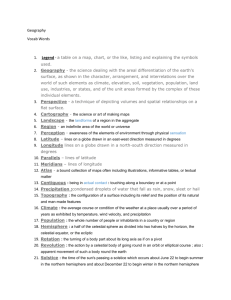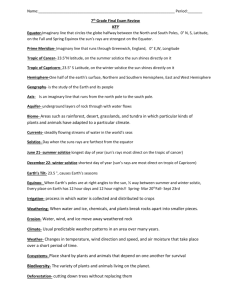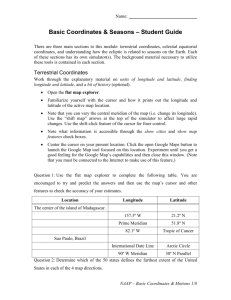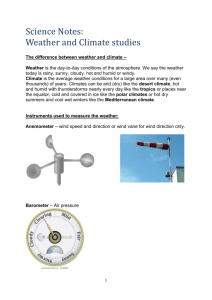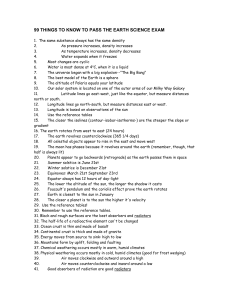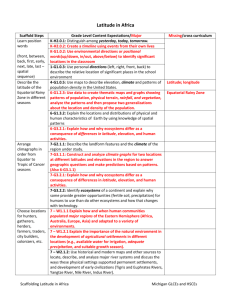Seasons and Ecliptic Worksheet: Astronomy Simulation
advertisement
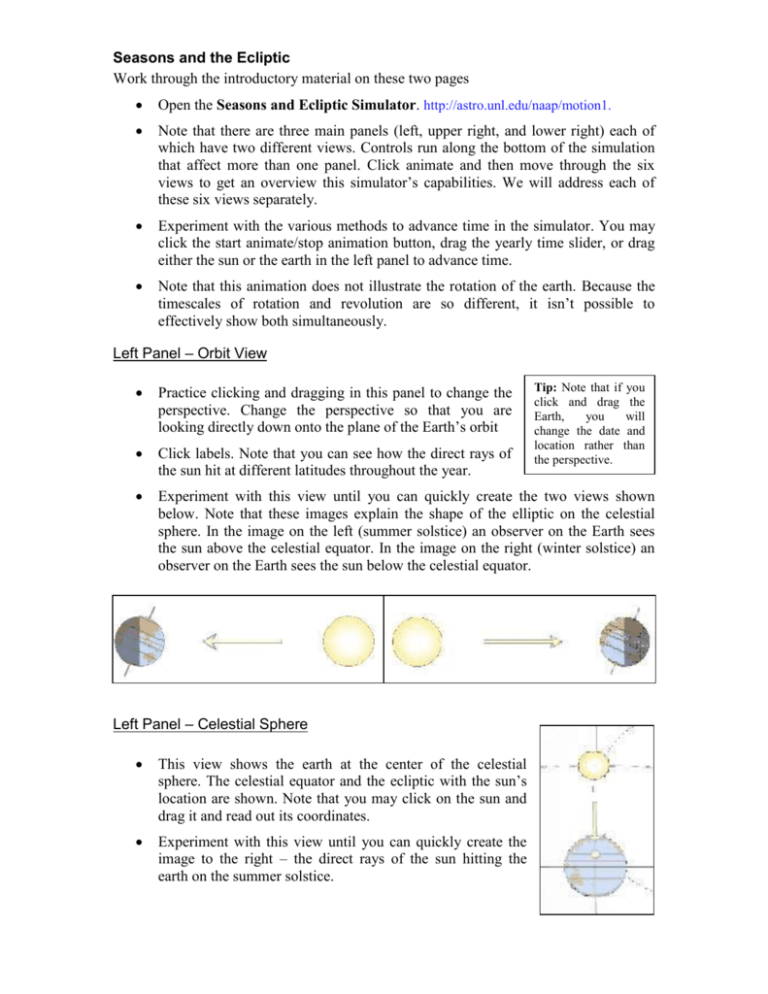
Seasons and the Ecliptic Work through the introductory material on these two pages Open the Seasons and Ecliptic Simulator. http://astro.unl.edu/naap/motion1. Note that there are three main panels (left, upper right, and lower right) each of which have two different views. Controls run along the bottom of the simulation that affect more than one panel. Click animate and then move through the six views to get an overview this simulator’s capabilities. We will address each of these six views separately. Experiment with the various methods to advance time in the simulator. You may click the start animate/stop animation button, drag the yearly time slider, or drag either the sun or the earth in the left panel to advance time. Note that this animation does not illustrate the rotation of the earth. Because the timescales of rotation and revolution are so different, it isn’t possible to effectively show both simultaneously. Left Panel – Orbit View Practice clicking and dragging in this panel to change the perspective. Change the perspective so that you are looking directly down onto the plane of the Earth’s orbit Click labels. Note that you can see how the direct rays of the sun hit at different latitudes throughout the year. Experiment with this view until you can quickly create the two views shown below. Note that these images explain the shape of the elliptic on the celestial sphere. In the image on the left (summer solstice) an observer on the Earth sees the sun above the celestial equator. In the image on the right (winter solstice) an observer on the Earth sees the sun below the celestial equator. Left Panel – Celestial Sphere This view shows the earth at the center of the celestial sphere. The celestial equator and the ecliptic with the sun’s location are shown. Note that you may click on the sun and drag it and read out its coordinates. Experiment with this view until you can quickly create the image to the right – the direct rays of the sun hitting the earth on the summer solstice. Tip: Note that if you click and drag the Earth, you will change the date and location rather than the perspective. Upper Right Panel – View from Sun This view shows the earth as seen from the sun. It gives the best view of the subsolar point – the location on the earth where the direct rays of the sun are hitting. The noon observer’s location on the Earth is indicated by a red parallel of latitude which can be dragged to new latitudes (this affects the appearance of the lower right panel). It is possible for the red parallel to be at an inaccessible location in this view. Create the image shown to the right – an observer at latitude 80°N on the summer solstice. Upper Right Panel – View from Side Tip: Once the stick figure is selected you can gain greater precision over its motion by moving the mouse a distance away from the figure. This view shows the earth as seen from a location in the plane of the ecliptic along a line tangent to the Earth’s orbit. It allows one to easily see the regions of the Earth that are in daylight and those that are in shadow. Dragging the stick figure allows one to very conveniently change latitude. Dragging the stick figure on top of the subsolar point effectively puts the observer at the latitude where the direct rays of the sun are hitting. Although rotation is suppressed in this simulation, keep in mind that the stick figure is on a planet that is rotating with a period of 24 hours about an axis connecting the north and south poles. Thus, 12 hours later it will be on the other side of the earth. Set up the simulator for the image at right – the winter solstice for an observer at 80 N. Since this observer’s parallel of latitude is located entirely in the shaded region, this observer will not see the sun on this day. Lower Right Panel – Sunbeam Spread This view shows a “cylinder” of light coming from the sun. It is projected on a grid to convey the area over which the light is spread. As this light is spread over a larger area, its intensity decreases. Lower Right Panel – Sunlight Angle This view shows the angle with which rays of sunlight are striking the Earth. It lists the noon sun’s angle with respect to the horizon (its altitude). Verify that when the noon observer is at the latitude where the most direct rays of the sun are hitting, the sun is directly overhead making an angle of 90 with the ground. Verify that when the noon observer is at the latitude where the least direct rays of the sun are hitting, the sun is on the horizon. Name: ___ Per:___ The table below contains entries for the coordinates for the latitude at which the most direct and least direct rays of the sun are hitting. Use the simulation to complete the table. Date Latitude of Most Direct Latitude of Least Direct Ray 16.5° N 73.5° S February 5 March 21 May 5 June 21 August 5 September 21 November 5 December 21 Using the data in the table above, formulate general rules relating the the sun to the latitude where the most direct and least direct rays of the sun are hitting. The region between the Tropic of Cancer and the Tropic of Capricorn is commonly known as the tropics. Using the sunlight data table from question 1, define the significance of this region. Using the sunlight data table from question 1, define the significance of the region north of the Arctic Circle commonly referred to simply as the Arctic. Use the simulator to complete the table below. For each latitude write a short paragraph which describes the variations in sunlight (seasons) that are experienced at this latitude throughout the year. Include what happens to the noon sun’s angular height above the horizon ranges at the Spring and Fall equinox, the Summer solstice, and the winter solstice. Then conclude what that means about the sun’s rays and the temperature due to that. Latitude 0° 23.5° N 41° N 66.5° N 90° N Description of Yearly Pattern of Sunlight The noon sun’s angular height above the horizon ranges from 90° on the Spring equinox, to 66.5° on the summer solstice, to 90° on the Fall equinox, and back to 66.5° on the winter solstice. Thus, the equator always receives very direct intense sunlight throughout the year which accounts for the very high temperatures.
